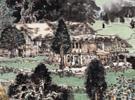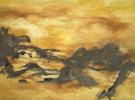Andy Warhol’s silkscreen style was more than brilliant aesthetic choice and critical displacement of Jackson Pollock’s drip technique, since Warhol placed his canvases horizontally to the floor in order to make them. Warhol’s quotidian iconography including Campbell’s soup cans and celebrities were conceptually charged via the flatness of his silk screen technique. This modus operandi underscores the painting’s surface, which is a formally ingenious way to highlight the artifice of his subject matter. Or, take for instance the painter Jorge Tacla, who mixes marble powder into his pigments not only for aesthetic reasons that gives his paint more density, but when he uses this viscous color to depict a church that is also constituted from marble, there is a semiotic connection between the mark’s meaning and what makes the mark. There is also Cildo Meireles, a conceptual artist whose sculpture titled Money Tree (1969) consists of rubber bands wrapped around money. The rubber bands are a formal, sculptural device, but they also act as part of the meaning of the work in addressing rubber as commodity which is made more complicated via the actual currency that it wraps; for the value of money, like rubber commodities, is contingent on the rise and ebb of international markets. In other words, these artists use matter linguistically rather than as elements of what they are narrating visually. In regard to Cheung’s deft formalism and his artistic articulation of The Sleeper Awakes, the trustees of Graham’s income have, through lobbying and other modes of political manipulation, set up a government in which their interests and those of the selected few eclipse the needs of the general population.
Mega-wealth and its corrupting influence on the machinations of the political are alluded to in Cheung’s riveting 10 portrait piece titled Top Ten Billionaires, 2008 (2009). The portraits include, respectively, the richest men on the planet during the year stated in the works title: Bill Gates, William Buffet, Carlos Slim Helu, Lawrence Ellison, Ingvar Kamprad, Karl Albrecht, Mukesh Ambani, Lakshmi Mittal, Theo Albrecht, and Amancio Ortega. Not only is the combined wealth by these 10 men staggering, but the network of multinational corporations across the globe makes the financial power vested in these individuals, and the merciless effort to sustain them, borderline conspiratorial. Cheung’s artistic brilliance manifests in playing off The Sleeper Awakes and Top Ten Billionaires, 2008 via his use of stock listings as foundation for his portraits. The stock listings are an index of contemporary global economic trading. But the poetics of this seemingly simple formal trope is that though the stock listings may be a register of a particular commodity’s worth in a specific moment in time, because it is now an element of an artwork that fluctuates within an art market, it becomes conceptually active. In a kind of inverse of the Duchampian readymade, Cheung’s readymade stock listings refer back somewhat to their original function. This Duchampian inversion is also a move made by the above mentioned Meireles in his Coca-Cola Project: Insertions into Ideological Circuits (1970). This work consists of empty Coca-Cola bottles that are returned back for recycling to be refilled with Coca Cola and then sent back out to commercial circulation. And to a lesser or greater degree, is what Cheung succeeds with his stock listings in being part of artworks that circulate within the art market and larger systems of finance. The latter scenario becomes even more apparent if a collector was to buy Top Ten Billionaires, 2008, solely as an investment.
Gordon Cheung’s candid portraits, in which some are in profile while others are frontal, are also derived from imagery that is not officially released to the media by the billionaires’ public relations machinery. What they reveal are imagery of powerful individuals who have been demystified; they are a kind of anti-icon in the way that Cheung has rendered them in an unguarded, ostensible offhandedness. But yet at the same time, there is still a sense of reification imbued in them. All the works are of the same size and share a similar palette, though Cheung’s highly recognizable trademark of dazzling explosive color achieved through his masterful use of gels and mixed media create a kaleidoscope of bleeding and coagulating polychromatic surfaces. There is, however, plentiful nuance in these works amidst their explosive spectra: for example, a blinding white light that emanates from on top of the heads of the portraits appear as if its source is from above, if not outside, of the picture plane. The effect is not unlike an aura or even a halo. While both of these words are somewhat synonymous, the aura, according to the Frankfurt School critic Walter Benjamin, is what imbues an artwork with the patina of history that differentiates it from any another mundane object. The halo, of course, is the antithesis to the secularity of the capitalist ethos and the business empires created in the fields of computers, property and causality insurance, telecommunications, steel production, investment banking and so forth. In alignment with the global nature of the Top Ten Billionaires, 2008 and the shadow government funded by Graham’s wealth, then, are two works whose animal iconography historically and culturally rubs up against each other in an archetypal duel: the Minotaur and the dragon
Both of these mythological creatures reflect polarities in respectively representing the West and the East. They are two cosmic creatures that are symbolically engaged in the contemporary geopolitical rivalry between Europe/the U.S., and Asia. The Minotaur is a particular animal that is a combination of the anthropomorphic and zoomorphic.
Its origins are in Greek mythology and it is a creature with the head of a bull on the body of a man or, as described by Ovid, "part man and part bull." He inhabited the center of a labyrinth that was designed as a maze, and this creature appears in other contexts not only in Greece, but is even referred to in Dante’s Divine Comedy. It was also appropriated by Sigmund Freud as a metaphor of the unconscious were it symbolized the labyrinth, while the Minotaur became the buried personification of repressed fear, desire, and unresolved conflict. The Asian dragon has many connotations as well, unlike the European dragon. It is the most auspicious sign in Chinese astrology, but has been characterized in the West as a symbolizing China. Cheung ‘s use of animals in The Sleeper Awakes is not limited to the Minotaur or the dragon, however, but there also other creatures that constitute what can be called his Trophy series.
The works that make up this series include images of bears, rams, and deer. In the West, it is not uncommon to go hunting for such animals and then have them mounted on walls as display. Yet this bestiary to masculinity can also highlight within the exhibition as commodities, the exploitation of natural resources, and even the possibility that these animals may die out. Extinction is one subtext of Wells’ The Sleeper Awakes, for one of the odd realities that Graham has awoken to is a London that is completely altered from 203 years earlier. This wasteland of a new, futuristic London is, if you will, also aptly alluded to in the exhibition in a series of sculptural works titled Conquerors (2009).
Conquerors are made from mirrors, florescent lights and cast animal skulls and human spines that bespeak of environmental cataclysm from rampant technology left unchecked. Cheung’s title, moreover, like other works that are left in a state of poetic ambiguity, can be reflexive in that they may refer both to the zoomorphic skulls as conquerors themselves, or are they the evidence of a wrath inflicted on them by humans? H.G. Wells’ story is ultimately dystopian, and these works cathartically convey this through their memento mori quality as well as alluding to an urn or some other kind of futuristic mortuary repository. Or, are these the extraterrestrial equivalents to the pictures of animals as trophies? The apocalyptical dimension of these works, which is a Wells’ trope par excellence in both War of the Worlds and The Sleeper Awakes, is very much embodied in four video animations titled The Four Riders (2009).
The Four Riders are analogues to the apocalyptic Four Horsemen envisioned by the Apostle John in the Book of Revelation. Like the Biblical horsemen who are divine harbingers of pestilence, death and destruction on earth’s final days, The Four Riders hint to this as well: each animation consists of a bull-riding cowboy endlessly riding in a circle. The beauty of this work resides in Gordon Cheung’s vision of a kind of cosmic phantom endlessly looping like the dance of Shiva the Destroyer, who concomitantly creates and destroys, and is the source of both life and death. Three of the animations have a mountain range distant in the background. It’s difficult to ascertain whether the mountain ranges are the Himalayas, The Rockies or even the Andes. What the animations do formally share is a kind of smoky haze that permeates the middle ground in which the bull-riding cowboy circumambulates for all eternity. Is this fog-like, apparition akin to psychic ether or cosmic ectoplasm, or simply modern pestilence in the form of chemical warfare?
As one is mesmerized by the haunting allure of these animations, what is faintly heard in their audio track is The End by the Doors; an iconic song that also appears in Francis Ford Coppola’s Apocalypse Now. Like “For whom the bells toll,” which is the philosopher John Donne’s metaphor for the Grim Reaper, Gordon Cheung’s use of The End and his exhibition is his trumpet call to us; but he does not signal us for the hour of our death, but rather to awake up from our sleep and greet the new dawn.




